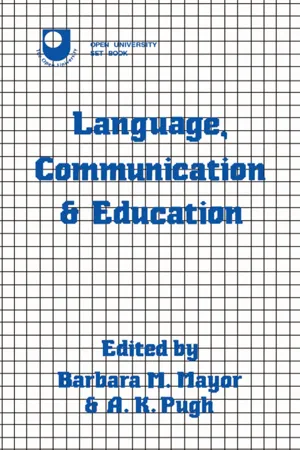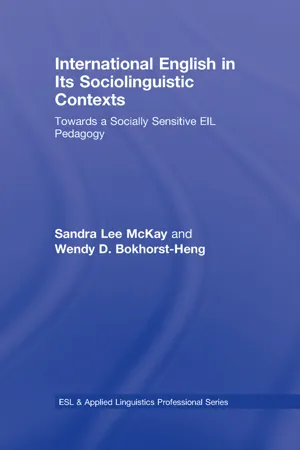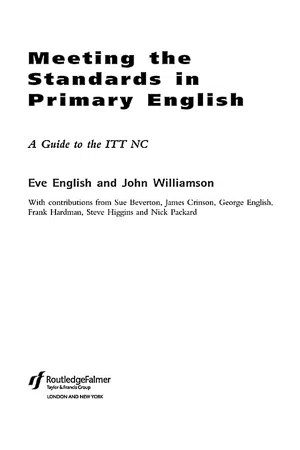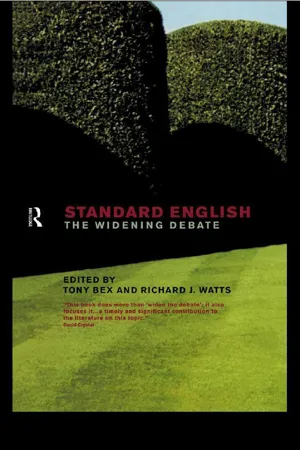Languages & Linguistics
Conventions of Standard English
Conventions of Standard English refer to the accepted rules and norms for grammar, punctuation, spelling, and usage in the English language. These conventions provide a framework for clear and effective communication, ensuring consistency and understanding across written and spoken language. Adhering to these standards is important for maintaining coherence and professionalism in written and verbal communication.
Written by Perlego with AI-assistance
Related key terms
10 Key excerpts on "Conventions of Standard English"
- eBook - ePub
- Barbara Mayor, A. K. Pugh(Authors)
- 2005(Publication Date)
- Routledge(Publisher)
It is not surprising, therefore, that there should be some widespread misunderstandings about standard English. One of these is that it is restricted only to formal kinds of utterance. This idea has gained acceptance, presumably, from its association in people’s minds with contexts and situations where power is exercised—the classroom, the courtroom, the institutions of government. But like any linguistic variety, the standard has its dimensions of variation, including that of informality-formality, since for many people it must function as the medium of everyday conversation. Unlike other varieties, though, it is peculiarly subject to debate and analysis—about what usage is permissible and what is held to be correct. As we shall see, this preoccupation with fixity has often acted as a kind of brake on the natural tendency towards variation and change.The standard is less fixed and monolithic than many suppose, partly because today it has a widely used spoken form (used, moreover, by many people without their realising it!). Since speech, by its very nature, is less amenable to being fixed than writing, the concept of standard English makes most sense when we are referring to the written word. When we are taught to write, it is standard English that we are taught. Moreover, this is largely true wherever English is learned in school; and the written standard is much the same in every part of the world where English is known and used.Source: Edited version of Chapter 2 of Leith, D. (1983) A Social History of English, London, Routledge & Kegan Paul, pp. 32–57.Writing, then, is an indispensable component of standardisation. Indeed, it is difficult to conceive of a standard variety without a written form. At the same time, the existence of a writing system does not presuppose the existence of a standard. For instance, West Saxon was used as a written standard in English in the tenth century when no spoken one existed. But once a standard variety has been selected, writing is a powerful agent for its dissemination especially as literacy spreads and printing makes written materials more readily available. As the written forms acquire prestige, and are considered to be ‘correct’, they increasingly exert a pressure on speech. The written standard acts as a norm, a yardstick, and a guide […] - eBook - ePub
International English in Its Sociolinguistic Contexts
Towards a Socially Sensitive EIL Pedagogy
- Sandra Lee McKay, Wendy D. Bokhorst-Heng(Authors)
- 2017(Publication Date)
- Routledge(Publisher)
It is the variety regarded as the ideal for educational purposes, and usually used as a yardstick by which to measure other varieties. The related notion of language standards has to do with the language rules that inform the standard, and that are then taught in schools. While this simple introduction may seem straightforward, definitions that have circulated in discussions about Standard English suggest it is in fact a much more contentious issue: • A particular dialect of English, being the only non-localized dialect, of global currency without significant variation, universally accepted as the appropriate educational target in teaching English; which may be spoken with an unrestricted choice of accent. (Strevens, 1983, p. 88) • The variety of the English language that is normally employed in writing and normally spoken by “educated” speakers of the language. It is also, of course, the variety of the language that students of English as a Foreign or Second Language (EFL/ESL) are taught when receiving formal instruction. The term Standard English refers to grammar and vocabulary (dialect) but not to pronunciation (accent). (Trudgill & Hannah, 2002, p. 1) • We may define the Standard English of an English-speaking country as a minority variety (identified chiefly by its vocabulary, grammar and orthography) which carries most prestige and is most widely understood. (Crystal, 1995, p. 110) For Strevens (1983), there is no standardized accent associated with Standard English. Others, such as Trudgill and Hannah (2002) and Crystal (1995) associate Standard English more directly with the written form of the language, and by extension, with the language used by “educated” speakers of English. The “educated” speakers of the language are defined by McArthur (1998) as the “more or less middle-class range throughout the English-speaking world … essentially those who have completed their secondary-school education [and] may have gone on to college-university” (p - eBook - ePub
Navigating the Common Core with English Language Learners
Practical Strategies to Develop Higher-Order Thinking Skills
- Larry Ferlazzo, Katie Hull Sypnieski(Authors)
- 2016(Publication Date)
- Jossey-Bass(Publisher)
Chapter Six LanguageLanguage is the dress of thought.—Samuel Johnson1What Does the Common Core Say About Language?
The Common Core Standards for Language (see Exhibit 6.1 ) emphasize knowing and using correct grammar, punctuation, spelling, and so forth. The high school standards are especially specific when it comes to grammar, and list terms that we hadn't seen since our linguistics courses (“absolute phrase, participial phrase”). The Standards also call for students to be able to use style guides (for example, APA or MLA). In addition, the language standards call for students to competently use various strategies to determine the meanings of words new to them, to understand the many nuances of language (such as figurative language) and to develop a wide-range of academic vocabulary.Key Elements of the Language Standards
The six Common Core Standards for language are divided into three parts—“Conventions of Standard English,” “Knowledge of Language,” and “Vocabulary Acquisition and Use”. Here is our interpretation of the most important points in each of these areas:Conventions of Standard English
The two standards here, as applied to high school, assume that most basic language conventions have already been acquired in earlier grades2 and suggest that it's time now for students to learn more complex and sophisticated ones.3 Fortunately, another specific application of these standards to high school is that students should develop the ability to find answers to their questions on conventions independently.4 As far as we're concerned, we place a much higher priority on the latter with our high school ELL students.Exhibit 6.1
- eBook - ePub
Meeting the Standards in Primary English
A Guide to ITT NC
- Eve English, John Williamson(Authors)
- 2004(Publication Date)
- Routledge(Publisher)
This should be illuminating for anyone with a good knowledge of the use of English in this country although it does leave the specifics of the grammar and vocabulary unmentioned. Wardhaugh (1992, p. 30) offers another way of thinking about the issue:Standardization refers to the process by which a language has been codified in some way. That process usually involves the development of such things as grammars, spelling books, and dictionaries, and possibly a literature . . . Standardization also requires that a measure of agreement be achieved about what is in the language and what is not.It may be helpful, then, to think of standard English as being that dialect of the language whose grammatical features, spelling and vocabulary can be verified in authoritative sources such as those mentioned. However, it should be noted that there is a danger of circularity here. What is standard English? It’s what you find in grammars and dictionaries. What gets put into grammars and dictionaries? Standard English. Good grammarians and lexicographers (dictionary-makers) try to avoid this difficulty by basing their work on studies of what people actually say and write. Of course, the ‘measure of agreement’ that Wardhaugh mentions probably covers the vast majority of features of standard English (which as we have seen are shared by all British English dialects) but we should be aware that the boundaries of standard English are not clear-cut, for several reasons. One of these is illustrated by Activity 1.Which, if any, of the following sentences are not examples of standard English?- Between you and I there’s nothing wrong with these sentences.
- I don’t know why people have to constantly look for mistakes.
- None of the mistakes here are serious.
- It’s different to speaking in a foreign language.
- Hopefully, we will be more tolerant in the future.
Well, the answer is, it depends on who you are talking to. (Or should I say ‘to whom you are talking’?) Many people would regard all of these as perfectly normal examples of standard English but many would object to them; in fact the sentences are based on a list of common complaints to the BBC about non-standard language. (You can find the grounds for some people’s objections at the end of this chapter.) There are, to sum up, cases of divided usage where people disagree about what precisely constitutes standard English. - eBook - ePub
Standard English
The Widening Debate
- Tony Bex, Richard J. Watts(Authors)
- 2002(Publication Date)
- Routledge(Publisher)
1 relating to them. This chapter will thus examine the different ways in which ‘standard’ has been used since the seventeenth century when referring to language and communication in lexicographical and lexicological contexts. It will also examine various cultural developments that provided the impetus for language standardisation.Honey claims in Language is Power that a standard variety of English was in common currency before the end of the sixteenth century:A standard variety of English, both spoken and written, was recognised as existing before the end of the sixteenth century, in the sense of an authorised, delimited and unitary standard, but that recognition of the ‘unitary’ character of that standard English—i.e., that it involved an essential unity of language—continued to be a matter of contention for a further two centuries.(Honey 1997 :75)However, it is only when language becomes the object of a field of study containing a set (or sets) of criteria for its institutionalised codification, that we arrive at what we understand to be ‘standard English’. This understanding owes its development to the inception of general linguistic theory with Saussure's concept of la langue (1922) and to the proposal for a new historical dictionary, later the Oxford English Dictionary (OED), in 1858 (Davis 1994 ). Indeed, prior to the publication of the OED, ‘standard English’ was a relatively unknown phrase. And, according to the OED supplement of 1933, the first attestation of the expression ‘standard English’ came from the text for its original proposals in 1858. Without a standard, codified language supposedly allowing all speakers at least the possibility of arriving at the same, unambiguous linguistic message, there would be no justification for the proposal that all members of a community should have access to this form of communication, whether it be ‘superior’ or ‘ordinary’. It is only when a society accepts that members of a speech community can understand each other because they share the same set of words with the same set of meanings, that we start talking about using a standard language. As Alfred Schutz wrote in 1962, ‘to be successful, any communicative process must…involve a set of common abstractions or standardizations’ (Schutz 1962 :323). And the veteran linguist John Lyons believes that the possibility of communication depends upon the existence of a ‘common core’ of language (Lyons 1968 ). This view of language and communication, although appearing plausible and commonsensical, only really came into existence as a theoretical postulate with the first publication in 1916 of Saussure's Course in General Linguistics. Here, Saussure provides an account of what he calls the ‘speech circuit’ (Saussure 1922 - eBook - ePub
- Larry Andrews(Author)
- 2000(Publication Date)
- Routledge(Publisher)
Understanding how conversations are structured in socially approved ways is an important attainment for the ENL learner, as you can appreciate. Although some of the discussion about discourse conventions may strike you as minute, atomistic, or clearly obvious, it is critically important for the ENL learner. These conventions are part of the sociolinguistic paste holding society together.Be a linguist. Based on what you know and what you have read, summarize some discourse conventions observed in the United States for these speech events:- Parent-teacher conference.
- Sitting beside a member of the clergy in an airplane.
- An interview with a prestigious school district.
TERMS OF ADDRESS
Native English speakers learn, often indirectly and implicitly, but sometimes as a result of direct intervention by their parents or older caregivers, when it is appropriate to use another person’s first name, last name, title, or some other term of address. These conventions, like many of the other conventions examined here, are also based on cultural values.For example, at the university where I studied for my PhD, all graduate students spoke both to and about their professors as “Dr. Artley,” “Dr. Woods,” “Dr. Voth,” and so on. When the professors spoke to the graduate students, it was always “Mr. Andrews,” “Mr. Guenther,” “Mr. Paden,” and “Mizz Proctor.” (The Mizz was used to cover either Miss or Mrs.)These were the terms of address conventions adhered to at one university. They were the conventions I learned and followed.You can imagine, I’m sure, how shocked I was during my first week at my first university appointment when a graduate student came to my office door and said, “Larry, a group of us is going to lunch. Would you like to join us?”What? You’re calling me Larry? Have you no respect?In time I came to understand that conventions governing terms of address in academè vary from campus to campus.Cultures will also use different terms of address for family relationship titles. As I reminded my in-laws in a speech at their 50th wedding anniversary celebration, “First they call you ‘Da-Da;’ then they call you ‘Daddy;’ then they call you ‘Dad;’ then they call you collect.” - eBook - ePub
On the Subject of English
The Linguistics of Language Use and Learning
- Henry Widdowson(Author)
- 2019(Publication Date)
- De Gruyter Mouton(Publisher)
In linguistics, as in everything else in life, one has to assume some stability. To see things steadily one has to see them whole: one can only make sense of anything by ignoring particulars, and a theory of language, like any theory, can only provide insights by restricting the view. So concepts like variety, standard language and native speaker competence have their value and are well suited to “received perspectives”. But what if these perspectives are not themselves well suited to changing circumstances which call them into question and create a need to think again conceptually? Whatever its doubtful theoretical status might be, Standard English is descriptively enshrined in grammars and dictionaries as authoritative sources of reference. Over recent years, these have been based on corpora of native speaker usage and it is this now that is commonly claimed to represent “real English”. But this in effect is a revised version of the standard which is still equated with native speaker norms. One can simply defer to the authority of these descriptions and ratify their reference status by accepting them as the officially sanctioned representation of the English language. Although this authorized version of native speaker English is taken to have a special and privileged status, it is, as is widely recognized, only one version, one variety of the language. There are many others. But this raises the question of what it is that varieties vary from. Variation presupposes some kind of stabilized norm. One can argue that the non-conformist features of non-standard varieties can be identified by reference to Standard English, and this indeed is how they are usually identified. But this does not mean that for their speakers, there is a reference norm of Standard English from which these features vary. These varieties develop independently as naturally dynamic and adaptive uses of language - Philip Seargeant, Ann Hewings, Stephen Pihlaja, Philip Seargeant, Ann Hewings, Stephen Pihlaja(Authors)
- 2018(Publication Date)
- Routledge(Publisher)
The standard ideology is promoted through public channels: in the past, standardization has first affected the writing system, and literacy has subsequently become the main influence in promoting the consciousness of the standard ideology. The norms of written and formal English have then been codified in dictionaries, grammars and handbooks of usage and inculcated by prescription through the educational system. Standardization through prescription has clearly been most successful in the written channel: in the daily conversation of ordinary speakers, however, it has been less effective. Indeed, the norms of colloquial, as against formal, English have not been codified to any extent.Precisely because of the fact that what counts as standard is deeply ideological, it is therefore not surprising to note that there is ‘no general consensus’ as to what Standard English is (Bex and Watts 1999: 1). That being said, possibly the best place to start appreciating the contemporary controversies and, indeed, anxieties surrounding standards in English is to consider the assertion made, for example, by Honey (1997, see also the discussion in Cameron 1995) that Standard English is the variety spoken and written by educated speakers.This is a highly controversial attempt to answer the question ‘What is Standard English?’ because it relies on a number of assumptions that appear to be problematic (see Crowley 1999). For one, since there are significant differences between the grammar of spoken and written English, characterizing both as Standard English simply evades the important question of how such differences do not undermine the claim of unity, that is, whether there is a need to distinguish between Standard Written English and Standard Spoken English. This is not a trivial issue because grammatical differences are also the kinds of things that presumably distinguish Standard English from its non-standard counterparts. This issue, if left unaddressed, means that we are left with the further and arguably even more perplexing question of how much variation (and of what kind) is tolerated before the differences in linguistic practices that distinguish Standard Written and Standard Spoken English become characterized as non-standard.A second point is that the group, ‘educated speakers’, that Honey relies on to ground his definition of Standard English is not at all homogeneous, since there are different levels of education and, of course, different educational institutions that enjoy varying degrees of prestige and credibility. All these considerations bring up the question of just what kind of education is needed before a speaker is deemed to be a speaker of Standard English. This in turn raises the highly contentious question of who decides that a speaker has been sufficiently educated to be considered a speaker of Standard English. Simply asserting that other speakers of Standard English are the best judges will not do because of the vicious circularity involved in this line of argument. Claiming that there is an ineffable nature to Standard English that is clearly recognized even by those who may not be competent in it is equally problematic because it shifts the grounds of argument from scholarly debate to matters of taste and faith, and raises the contentious issue of who specifically ought to be the arbiters of such taste and faith. This shift needs to be avoided as far as possible because, as we will see shortly, what counts as Standard English can significantly impact on the social and economic fortunes of individuals. The intersection between Standard English and matters of social justice is too important to be left to the tastes and faith of a (self-)selected few.- eBook - ePub
Language and Nationality
Social Inferences, Cultural Differences, and Linguistic Misconceptions
- Pietro Bortone(Author)
- 2021(Publication Date)
- Bloomsbury Academic(Publisher)
A descriptive grammar of x are usually seeking a kind of instruction and guidance that is fundamentally prescriptive. And ultimately, even urging people to speak their ‘natural’ vernacular, and encouraging them to avoid ‘prescriptive’ styles, entails being prescriptive.Language normativity is definitely, in many ways, illiberal; but language is anyway based on the development and partial maintenance of rules and norms – an important point elaborated by Cameron (2012: 2–3). Language is made of socially selected rules, in its structure as much as in its pragmatics. Therefore corrections, disapproval, and value judgments of other people’s (and one’s own) usage are also part of language use, not just of a particular prescriptivist approach. Almost everybody has opinions as to what is linguistically ‘better’ – because they deem it clearer, appropriate to the occasion, or somehow more beautiful. Indeed, diachronic change in language, as we mentioned before, is partly due to social attitudes and social changes.Imposing whose standard?An important positive aspect of the standardization of languages that must be noted is that, in several cases, the language variety that was elevated to the role of the national standard was a variety much closer to the people’s spoken language than the archaic or foreign language previously used as official and written medium. In those cases, the creation of such national standard was an altogether democratic step. However, the living language or dialect that gets elevated to national standard is sometimes not the most common among the population, and is selected for ideological reasons. For example, at the time of the foundation of the state of Pakistan in 1947, Urdu was spoken by a minority, but was chosen over languages with many more millions of speakers because Urdu fitted a distinctly Muslim identity for the new state (Simpson 2007: 8). Above all, a standard language is very commonly correlated, indeed doubly correlated, with social class. It is, recursively, both a cause of social hierarchies and a consequence - eBook - ePub
- Laurel Brinton, Alexander Bergs, Laurel Brinton, Alexander Bergs(Authors)
- 2017(Publication Date)
- De Gruyter Mouton(Publisher)
the standardless period of English. The absence of a standard is all the more a defining quality of Middle English because what we regard to be the “beginning of Middle English” coalesces with the disappearance of the so-called “West-Saxon Literary Standard”, so that Roy Liuzza (2000: 145) could claim that “the end of […] scribal training [in the West-Saxon standard] was the beginning of ‘Middle English’”. Moreover, in the last century of the Middle English period the vernacular is generally supposed to be under way towards Modern Standard English. Situated between the disappearing of one written standard and the slow emerging of a new standard, Middle English therefore “exhibits by far the greatest diversity in written language of any period before or since” (Milroy 1992: 156). The reasons for this linguistic scenario lie in the specific language situation resulting from the cultural impact of the Norman Conquest on the one end and the rapidly increasing use of English in writing for various purposes on the other.This chapter is structured in such a way that Section 2 discusses different concepts of the notions “standardization” and “standard” as they are applicable to Middle English. Section 3 subsequently discusses “standardized varieties” of English which have been identified mainly on the ground of unified spellings, and, in the 14th and 15th centuries, also in terms of the spread of dialectally bleached forms which could function supralocally. Section 4 then concentrates on the extensive and intensive elaboration of written English in the 14th and 15th centuries. Section 5 gives a brief summary of the main aspects addressed in the chapter.2Standardization(s) and standards
In general the idea of standardization is based on a concept of fixing and fixity of what would otherwise vary more or less freely. As the prime – and for a long time sole – means of fixing (a) language, writing potentially produces such models that minimize variation. However, writing is a necessary, but not a sufficient, condition for such a specific variety to emerge because it seems to take further socio-pragmatic motivations and textualization efforts for a standard variety to become established. Under “socio-pragmatic” shall be subsumed such standardizing moves that modify written language to serve a wider geographical range of communication. By “textualization efforts” I refer to orientation towards standards already established by existing literate models that will be called “discourse traditions”, a notion specifically apt to account for the unique literary communicative space of the period under consideration. As shall be seen, the former moves reduce variation while the latter efforts enhance variability.
Index pages curate the most relevant extracts from our library of academic textbooks. They’ve been created using an in-house natural language model (NLM), each adding context and meaning to key research topics.









